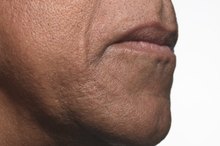What does fact checked mean?
At Healthfully, we strive to deliver objective content that is accurate and up-to-date. Our team periodically reviews articles in order to ensure content quality. The sources cited below consist of evidence from peer-reviewed journals, prominent medical organizations, academic associations, and government data.
- PubMed: “Toxicology and Applied Pharmacology”; Toxicity of indium arsenide, gallium arsenide, and aluminium gallium arsenide; A. Tanaka; 2004
- PubMed: “Toxicology and Applied Pharmacology”; Toxicity of indium arsenide, gallium arsenide, and aluminium gallium arsenide; A. Tanaka; 2004
The information contained on this site is for informational purposes only, and should not be used as a substitute for the advice of a professional health care provider. Please check with the appropriate physician regarding health questions and concerns. Although we strive to deliver accurate and up-to-date information, no guarantee to that effect is made.
Health Risks of High Power LED Lights
Light-emitting diodes, more commonly called LEDs, are used in a variety of ways, including in automotive and home lighting, video displays and traffic signals. LEDs are energy efficient and can last up to three years. They’re also easier to recycle than the compact fluorescent lighting bulbs due to the mercury content in CFLs. An LED is a semiconductor diode that releases energy in the form of light when it’s switched on. There are a couple of health concerns to be aware of when it comes to LEDs.
Worries for the Workplace
Red LEDs are made from a toxic substance called aluminum gallium arsenide, or AGA 2. Chronic and acute toxicity causes kidney, lung and reproductive organ problems in animals, Tanaka notes. Given that, Tanaka recommends paying much greater attention to human exposure to such semiconductor materials.
Consumer Concerns
Photochromic Vs. Polarized Sunglasses
Learn More
LED lights have been criticized by people who are worried they’ll cause damage to the retina of your eye. Accumulation of cellular debris called lipofuscin in your retinal pigment epithelium is responsible for the damage. However, the amount of harm an LED lamp can cause depends on the built-in protection of the product, according to Dan Roberts, director of Macular Degeneration Support, a nonprofit organization based in Missouri. The bigger and brighter the illumination source, the more potential risk it has for your retina. Small white LEDs in lamps are unlikely to lead to many problems, Roberts says. Proximity and whether you take reasonable precautions are other factors. For example, the International Commission on Non-Ionizing Radiation Protection suggests that you should not look directly into a light box from up close for longer than a maximum of 100 seconds. LED are directional lights, meaning they don’t radiate light 360 degrees like CFLs do, notes the Environmental Protection Agency 3. Blue light waves are more likely to cause harm to the retina among people who are prone to macular issues due to aging, environment, genetics or health habits, Roberts says.
- LED lights have been criticized by people who are worried they’ll cause damage to the retina of your eye.
- However, the amount of harm an LED lamp can cause depends on the built-in protection of the product, according to Dan Roberts, director of Macular Degeneration Support, a nonprofit organization based in Missouri.
The Good News
If you choose CFLs over LEDs, you can combat “dirty electricity” with filters, notes Paul Henderson in the Vitality magazine article, “Why Your Appliances Might be Making You Sick.” Some people are more prone to be affected by “dirty electricity” due to electrical hypersensitivity, or EHS, Henderson notes. According to the World Health Organization, EHS is characterized by a variety of symptoms that are non-specific and differ among individuals. WHO says the symptoms are real, and can even be a disabling problem, though they may be due to other environmental factors like poor indoor air quality or poor ergonomic design of computer work stations. No diagnostic criteria for EHS existed as of 2010. WHO advises doctors to focus on health symptoms rather than a person's perceived need for eliminating or reducing exposure to “dirty electricity.”
- If you choose CFLs over LEDs, you can combat “dirty electricity” with filters, notes Paul Henderson in the Vitality magazine article, “Why Your Appliances Might be Making You Sick.” Some people are more prone to be affected by “dirty electricity” due to electrical hypersensitivity, or EHS, Henderson notes.
Related Articles
References
- CNET News: Superhuman Vision May be on the Horizon
- PubMed: “Toxicology and Applied Pharmacology”; Toxicity of indium arsenide, gallium arsenide, and aluminium gallium arsenide; A. Tanaka; 2004
- Environmental Protection Agency: Mercury-Containing Light Bulb FAQ
- “Zapped”; Ann Louise Gittleman; 2010
- Popular Mechanics magazine: Will LED Light Bulbs Best Your CFLs and Incandescents?
Writer Bio
Linda Tarr Kent is a reporter and editor with more than 20 years experience at Gannett Company Inc., The McClatchy Company, Sound Publishing Inc., Mach Publishing, MomFit The Movement and other companies. Her area of expertise is health and fitness. She is a Bosu fitness and stand-up paddle surfing instructor. Kent holds a bachelor's degree in journalism from Washington State University.









